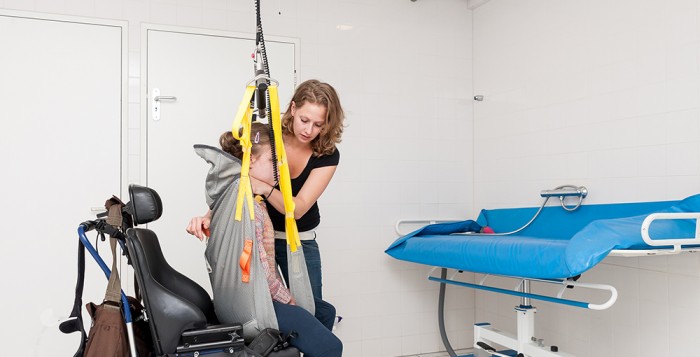The Centers for Medicare and Medicaid Services (CMS) recently announced the availability of a revised inpatient rehabilitation facility prospective payment system (IRF PPS) Medicare Learning Network (MLN) booklet. Topics in the booklet include: IRF PPS Elements (including rates, classification criterion, compliance percentage, and reasonable and necessary criteria); payment updates; IRF quality reporting program (QRP) measures for annual payment update; and many resources.
inpatient rehabilitation facility prospective payment system
FY 2020 IRF PPS Final Rule Released
On July 31, 2019, the Centers for Medicare and Medicaid Services (CMS) released the fiscal year (FY) 2020 inpatient rehabilitation facility prospective payment system (IRF PPS) final rule. This final rule is scheduled to be published in the Federal Register on August 8, 2019.
Key provisions contained in the final rule include:
- Motor Score Provisions: Based on feedback received with the proposed rule, CMS is adopting an unweighted motor score to assign patients to case-mix groups (CMGs), rather than the use of a weighted motor score as originally proposed. CMS also finalized as proposed the removal of GG0170A1 (roll left and right) from the motor score (leaving 18 unweighted data items).
- CMGs, Relative Weights, & Average Length of Stay: The final rule includes three additional CMGs than were included in the proposed rule:
- Stroke RIC (01) will have 6 CMGs, compared to 7 in the proposed rule
- Non-traumatic spinal cord injury RIC (05) will have 5 CMGs, compared to 4 in the proposed rule
- Replacement of lower extremity joint RIC (08) will have 5 CMGs, compared to 4 in the proposed rule
- Rheumatoid other arthritis CMG RIC (13) will have 5 CMGs, compared to 4 in the proposed rule
- Major multiple trauma without brain or spinal cord injury RIC (15) will have 5 CMGs, compared to 4 in the proposed rule
- Rebasing and Revising IRF Market Basket: CMS is rebasing and revising the IRF market basket to reflect a 2016 base year and is forecasted to be 2.9 percent.
- Clarification of “Rehabilitation Physician”: CMS is amending the regulations to clarify that the determination as to whether a physician qualifies as a rehabilitation physician (that is, a licensed physician with specialized training and experience in inpatient rehabilitation) is to be determined by the IRF, as the provider is in the best position to make that determination.
- Ensuring Quality: CMS finalized two new quality measures to implement the final requirements of the Improving Medicare Post-Acute Transformation (IMPACT) Act. Those two measures are: 1) Transfer of Health Information (TOH) from IRF to another Provider, and 2) Transfer of Health Information (TOH) from IRF to the Patient.
- IRF Quality Reporting Program (QRP): CMS is adopting two new quality measures that satisfy the IMPACT Act domain pertaining to the transfer of health information when a patient is transferred or discharged from the IRF to another PAC provider or the home of the individual. Specifically, both of these measures would assess whether the IRF provides a reconciled medication list at the time of transfer or discharge. They also support the CMS Meaningful Measures initiative of promoting effective communication and coordination of care, specifically the meaningful measure area of the transfer of health information and interoperability. In addition, CMS is adopting a number of standardized patient assessment data elements
(SPADEs). These SPADEs assess key domain areas including functional status, cognitive function and mental status, special services, treatments and interventions, medical conditions and comorbidities, impairments, and social determinants of health (SDOH). The addition of these SPADEs to the IRF-Patient Assessment Instrument (IRF-PAI) will improve coordination of care and enable communication between PAC providers and other members of the health care community, aligning with CMS’ strategic initiative to improve interoperability. CMS is also updating the specifications for the Discharge to Community PAC IRF QRP measure to exclude baseline nursing home residents. CMS is also finalizing their policy to no longer publish a list of compliant IRFs on the IRF QRP website. CMS proposed to collect standardized patient assessment data and other data required to calculate quality measures using the IRF PAI on all patients, regardless of the patient’s payer; however, in response to stakeholder feedback, they have decided not to finalize this proposal.
The payment provisions contained in the final rule become effective for discharges on or after October 1, 2019 and the new quality reporting requirements go into effect on October 1, 2020. Contact RCPA Director of Rehabilitation Services Melissa Dehoff with questions.
CMS Issues Correction to FY 2020 IRF PPS Proposed Rule
The Centers for Medicare and Medicaid Services (CMS) identified a typographical error in the publication of the fiscal year (FY) 2020 inpatient rehabilitation facility prospective payment system (IRF PPS) proposed rule that was published in the April 24, 2019 Federal Register. The error was in the calculation of the estimated burden for the IRF quality reporting program (QRP).
On page 17329 of the proposed rule it states, “Specifically, we believe that there will be an addition of 7.4 minutes on admission, and 11.1 minutes on discharge, for a total of 8.9 minutes of additional clinical staff time to report data per patient stay.” This sentence should have stated, “Specifically, we believe that there will be an addition of 7.8 minutes on admission, and 11.1 minutes on discharge, for a total of 18.9 minutes of additional clinical staff time to report data per patient stay.”
The final values and the overall burden proposed in the rule are correct despite these minor typographical errors. CMS will correct the figures in the final rule. A technical correction will not be issued due to the nature of the errors.
Contact Melissa Dehoff, RCPA Rehabilitation Services Division Director, with questions.
National Provider Call on IRF Final Rule Announced
The Centers for Medicare and Medicaid Services (CMS) recently announced they will be holding a National Provider Call for inpatient rehabilitation facilities (IRFs) that will focus on the changes included in the fiscal year (FY) 2019 inpatient rehabilitation facility prospective payment system (IRF PPS) final rule. The call is scheduled for Thursday, November 15, 2018 from 1:30 pm – 3:00 pm.
As a reminder, some of the key changes contained in this final rule, which will be a part of this discussion, included:
- Revisions to coverage criteria;
- Removal of the Functional Independence Measure (FIM) and Associated Function Modifiers from the inpatient rehabilitation facility patient assessment instrument (IRF PAI); and
- Refinements to the case-mix classification.
Prior to the call, participants are encouraged to review the Medicare Benefit Policy Manual, Chapter 1, Section 110. A question and answer session will follow the presentation; however, attendees may email questions in advance with “November 15 Call” in the subject line. These questions may be addressed during the call or used for other materials following the call.
Registration is required to participate in this call and will close by 12:00 pm on the day of the call or when it is full. RCPA encourages all of its members in the Rehabilitation Services Division to participate in this call to ask questions, share concerns, etc. with CMS.
Questions can be directed to Melissa Dehoff.
CMS Issues FY 2018 IRF PPS Final Rule
On July 31, 2017, the Centers for Medicare and Medicaid Services (CMS) released the fiscal year (FY) 2018 inpatient rehabilitation facility prospective payment system (IRF PPS) final rule. Some of the key provisions contained in the final rule include:
Updates to IRF Payment Rates
Update to the Standard Payment Rates
CMS finalized an update to the IRF PPS payments to reflect a 1.0 percent increase factor, in accordance with section 1886(j)(3)(C)(iii) of the Social Security Act, as added by section 411(b) of the Medicare Access and CHIP Reauthorization Act of 2015 (MACRA). An additional approximate 0.1 percent decrease to aggregate payments due to updating the outlier threshold results in an overall estimated update for FY 2018 of approximately 0.9 percent (or $75 million), relative to payments in FY 2017.
Update to CMG Weights, Lengths of Stay and Comorbidities
CMS updated the Case Mix Group (CMG) weights based on FY 2015 IRF cost report data and the FY 2016 IRF claims data, as well as the average lengths of stay (ALOS) per CMG. The final rule estimates 99.3 percent of all IRF cases are in CMGs and tiers that would experience less than a five percent change in the CMG relative weight under their proposal.
Rural Adjustment Transition
FY 2018 is the third and final year of the phase-out of the 14.9 percent rural adjustment for the 20 IRF providers that were designated as rural in FY 2015 and changed to urban under the new Office of Management and Budget (OMB) delineations in FY 2016. As a result, the rural adjustment for these IRF’s will no longer be applied.
ICD-10-CM Presumptive Compliance Coding Changes
CMS made refinements to the ICD-10-CM lists used in determining IRFs’ presumptive compliance with the 60 Percent Rule. The complete lists of the adopted code revisions are available for download on the IRF Data Files website. CMS notes that the version of these finalized lists will constitute the baseline for any future updates to the presumptive methodology lists. The changes will be effective for discharges on or after October 1, 2017. CMS adopted only those coding changes that will increase the number of cases counting toward presumptive compliance and did not adopt any changes that would remove codes from counting toward the presumptive compliance threshold. CMS also stated that since it is not making any negative changes, it would consider the comments it received on the need for a delayed effective dates should any of these negative changes occur in future rulemakings.
For FY 2018, the following refinements to the ICD-10-CM lists used in determining IRFs’ presumptive compliance to ensure that these lists reflect as accurately as possible the types of patients that should count presumptively toward the 60 percent rule were finalized by:
- Counting certain ICD-10-CM diagnosis codes for patients with traumatic brain injury and hip fracture conditions; and
- Revising the presumptive methodology list for major multiple trauma by counting IRF cases that contain two or more of the ICD-10-CM codes from three major multiple trauma lists in the specified combinations.
CMS did not finalize the proposal to remove certain ICD-10-CM codes from the presumptive methodology at this time indicating they would continue to monitor and consider their appropriateness for inclusion on the presumptive methodology lists for future policy development and rulemaking.
Other Policy Changes
CMS proposed several changes for the purposes of eliminating redundancies and simplifying administrative burden for providers and for the agency and finalized the following:
- Remove the 25 percent payment penalty for late submissions of the IRF PAI beginning October 1, 2017;
- Remove the voluntary swallowing assessment item (Item 27) in the IRF PAI beginning October 1, 2017; and
- Use the height/weight items on the IRF PAI (items 25A and 26A) to determine patients’ BMI greater than 50% for cases of lower extremity single joint replacement.
IRF Quality Reporting Program (QRP)
Under the IRF QRP, the applicable annual payment update for any IRF that does not submit the required data to CMS is reduced by 2 percentage points. In this final rule, CMS is finalizing the replacement of the current pressure ulcer measure with an updated version of that measure, as well as the removal of the All-Cause Unplanned Readmission Measure for 30 Days Post-Discharge from IRFs (NQF #2502). CMS is also finalizing the public display of six additional quality measures on the IRF Compare website in calendar year 2018.
In addition to the proposals related to quality measures and public reporting, CMS is finalizing that the data IRFs submit on the measure Percent of Residents or Patients with Pressure Ulcers That Are New or Worsened (Short Stay) (NQF #0678) meet the definition of standardized patient assessment data for the FY 2019 IRF QRP. For the FY 2020 IRF QRP, CMS is finalizing that the data IRFs submit on the measures Application of Percent of Long-Term Care Hospital Patients with an Admission and Discharge Functional Assessment and a Care Plan That Addresses Function (NQF #2631) and Changes in Skin Integrity Post-Acute Care: Pressure Ulcer/Injury meet the definition of standardized patient assessment data. However, in response to the comments received for the FY 2020 program year, CMS is not finalizing the proposed additional standardized data elements.
Request for Information
CMS also included a Request for Information (RFI) in the proposed rule for continuing feedback on the Medicare Program. Input was requested on potential regulatory, sub-regulatory, policy, practice and procedural changes to make the delivery system less bureaucratic and complex, reduce burden for clinicians and providers, and increases quality of care while decreasing cost. CMS said it would not respond to RFI comment submissions in the final rule, but rather will actively consider all input in developing future regulatory proposals or future sub-regulatory guidance. There was no response provided in the final rule.
The final rule will be published in the August 3, 2017 Federal Register, which will be sent to members upon publication.
CMS Announces FY 2018 IRF PPS Proposed Rule
On April 27, 2017, the Centers for Medicare and Medicaid Services (CMS) released the display version of the fiscal year (FY) 2018 inpatient rehabilitation facility prospective payment system (IRF PPS) proposed rule.
Some of the key provisions are provided below; a more detailed analysis of the proposed rule with be forthcoming following the publication of the proposed rule in the May 3, 2017 Federal Register. In addition, CMS published a Fact Sheet that highlights the major provisions of the proposed rule.
ICD-10-CM Presumptive Compliance Coding Changes
CMS is proposing to make refinements to the ICD-10-CM lists used in determining IRFs’ presumptive compliance with the 60 percent rule. The complete lists of proposed code revisions are available for download on the IRF PPS website. CMS notes that the version of these lists that is finalized in conjunction with the FY 2018 IRF PPS final rule will constitute the baseline for any future updates to the presumptive methodology lists. The codes include:
- TBI and Hip Fracture Codes
The proposed rule addresses certain ICD-10-CM diagnosis codes for patients with traumatic brain injury (TBI) and hip fracture conditions. CMS proposes to include such codes in counting towards presumptive compliance when they are used as an etiologic diagnoses in the following IGCs effective October 1, 2017:
Brain Dysfunction – 2.21 Traumatic, Open Injury;
Brain Dysfunction – 2.22 Traumatic, Closed Injury;
Orthopedic disorders – 8.11 Status Post Unilateral Hip Fracture; and
Orthopedic disorders – 8.11 Status Post Bilateral Hip Fracture.
The complete list of TBI and hip fracture ICD-10-CM codes is available for download on the CMS IRF PPS website.
- Major Multiple Trauma Codes
CMS also proposes changes to address major multiple trauma codes that did not translate exactly between ICD-9-CM and ICD-10-CM. Specifically, CMS proposes to count IRF Patient Assessment Instruments (PAIs) that contain 2 or more of the ICD-10-CM codes from the three major multiple trauma lists that can be downloaded here. In order for patients with multiple fractures to qualify as meeting the 60 percent rule requirement for IRFs under the presumptive methodology, codes from the following lists could be used if combined as CMS describes in the proposal whereby (a) at least one lower extremity fracture is combined with an upper extremity fracture and/or rib/sternum fracture or b) fractures are present in both lower extremities:
List A: Major Multiple Trauma—Lower Extremity Fracture
List B: Major Multiple Trauma—Upper Extremity Fracture
List C: Major Multiple Trauma—Ribs and Sternum Fracture
- Removed Codes and Other Proposals
CMS proposes to remove certain non-specific and arthritis diagnosis codes that were inadvertently reintroduced through the ICD-10-CM conversion process, and removing one ICD-10-CM code (G72.89 – Other specified myopathies) that was identified as being inappropriately applied to patients with generalized weakness, instead of to patients with clinically identified myopathies. Specifically CMS is proposing to remove 15 codes related to rheumatoid polyneuropathy with rheumatoid arthritis.
Request for Information
CMS also included a Request for Information (RFI) for continuing feedback on the Medicare Program. Feedback is requested on potential regulatory, sub-regulatory, policy, practice and procedural changes to make the delivery system less bureaucratic and complex, reduce burden for clinicians and providers, and increases quality of care while decreasing cost. CMS asked to be provided with clear and concise proposals that include data and specific examples. CMS will not respond to RFI comment submissions in the final rule, but rather will actively consider all input in developing future regulatory proposals or future sub-regulatory guidance. Ideas addressing opioid use disorder and other substance use disorders is a big area of interest.
IRF Classification Criteria
CMS is also specifically seeking stakeholder input on the 60 percent rule, including but not limited to, the list of 13 conditions used to evaluate 60 percent rule compliance.
Proposed Future Measures
Transfer of Information Measures
CMS is developing two Improving Medicare Post-Acute Care Transformation (IMPACT) Act-required measures regarding post-acute care providers’ Transfer of Information. It intends to specify these measures by October 1, 2018 and propose them for adoption in the FY 2021 IRF QRP, with data collection beginning “on or about” October 1, 2019. The measures are 1) Transfer of Information at Post-Acute Care Admission, Start or Resumption of Care from other Providers/Settings, and (2) Transfer of Information at Post-Acute Care Discharge, and End of Care to other Providers/Settings. Experience of Care and Patient-Reported Pain
CMS is developing an experience of care survey for IRFs, and survey-based measures will be developed from this survey. The survey explores experience of care across five main areas: (1) beginning stay at the rehabilitation hospital/unit; (2) interactions with staff; (3) experience during the rehabilitation hospital/unit stay; (4) preparing for leaving the rehabilitation hospital/unit; and (5) overall rehabilitation hospital/unit rating. CMS is also considering a patient-reported pain measure, Application of Percent of Residents Who Self-Report Moderate to Severe Pain (Short Stay) (NQF #0676), for future rulemaking.
Public Reporting
CMS proposes to publicly report data on six additional measures:
- Application of Percent of Long-Term Care Hospital (LTCH) Patients With an Admission and Discharge Functional Assessment and a Care Plan That Addresses Function (NQF #2631) (assessment-based);
- Application of Percent of Residents Experiencing One or More Falls with Major Injury (NQF #0674) (assessment-based);
- Medicare Spending Per Beneficiary-PAC IRF QRP (claims-based);
- Discharge to Community-PAC IRF QRP (claims-based);
- Potentially Preventable 30-Day Post-Discharge Readmission Measure for IRF QRP (claims-based); and
- Potentially Preventable within Stay Readmission Measure for IRFs (claims-based).
Comments on the proposed rule will be accepted until June 27, 2017. Discussion on the provisions of this proposed rule will be included as an agenda topic at the June Medical Rehabilitation Committee meeting.
FY 2017 IRF Final Payment Rule Released
The Centers for Medicare and Medicaid Services (CMS) released the fiscal year (FY) 2017 inpatient rehabilitation facility (IRF) prospective payment system (PPS) final rule in today’s Federal Register.
The majority of the final rule focuses on changes in the IRF Quality Reporting Program (QRP), pursuant primarily to the requirements of the Improving Medicare Post-Acute Care Transformation (IMPACT) Act of 2014. The rule continues to address implementation of the IMPACT Act requirements regarding resource use and quality measures, adding five new measures to the IRF QRP. Four measures will begin October 1, 2016, and are collected from Medicare claims data, so no additional reporting action from providers is required. These four measures include:
- Discharge to Community – Post-Acute Care (PAC) IRF QRP (claims-based);
- Medicare Spending Per Beneficiary (MSPB) – PAC IRF QRP (claims-based);
- Potentially Preventable 30 Day Post-Discharge Readmission Measure for IRFs (claims-based); and
- Potentially Preventable Within Stay Readmission Measure for IRFs (claims-based).
The remaining measure, Drug Regimen Review Conducted with Follow-up for Identified Issues, will begin October 1, 2018, and will require additional items on the IRF Patient Assessment Instrument (IRF PAI).
Other key provisions included in the final rule:
Standard Payment Rate
The standard payment rate conversion factor will increase in FY 2017 to $15,708, compared to the proposed amount of $15,674. This amount is the result of a 2.7 percent rehabilitation-specific market basket increase, minus a productivity adjustment of 0.3 percent and a 0.75 percent ACA adjustment. The FY 2016 standard payment rate conversion factor was $15,478.
CMS used the rehabilitation market basket for the first time. It was adopted last year. The standard payment update also accounts for budget neutrality factors for the wage index and labor related share of 0.9992 and for the CMG weight revisions of 0.9992 plus changes to the outlier threshold. Table 5 in the rule (not reproduced here) displays the FY 2017 payment rates.
Update to the CMG Weights, Lengths of Stay, and Comorbidities
CMS updated the Case Mix Group (CMG) weights using FY 2014 cost report data and the FY 2015 claims data as well as the average lengths of stay (ALOS) per CMG. Approximately 99.5 percent of the cases affected by the change in weights would be changed by less than 5 percent.
Outlier Threshold
CMS updates the outlier threshold amount to $7,984 from $8,658 for FY 2016 in order to maintain the outlier payments at three percent of total IRF payments in FY 2017. The national cost-to-charge ratio ceiling for FY 2017 is 1.29; the ceiling for rural IRFs is 0.522 and 0.421 for urban IRFs.
ICD-10-CM Presumptive Compliance Coding Changes
Unfortunately, CMS did not address the problems with the ICD-10-CM codes which eliminated certain key diagnoses from being allowed for consideration in calculating a provider’s presumptive compliance in meeting the 60 percent rule. The largest set of affected codes fall into the area of brain injury under IGCs 2.21 and 2.22.
CMS did, however, comment that IRFs are permitted to use “D” as an eligible seventh character for traumatic brain injury diagnosis codes on both the claim and the IRF PAI. However, for the reasons indicated in the FY 2015 IRF PPS final rule effective with discharges occurring on or after October 1, 2015, ICD-10-CM codes with the seventh character extension of “D” are not included in the ICD-10-CM versions of the “List of Comorbidities,” “ICD-10-CM Codes That Meet Presumptive Compliance Criteria,” or “Impairment Group Codes That Meet Presumptive Compliance Criteria.”
The payment changes to the rule will apply to IRF discharges on or after October 1, 2016 and before September 30, 2017. The quality reporting requirements are effective for discharges on or after October 1, 2106.
A more complete analysis of the rule will be forthcoming and reviewed/discussed extensively at the upcoming RCPA Outpatient Rehabilitation Committee meeting on Thursday, August 18, 2016, and the Medical Rehab Committee meeting on Thursday, September 8, 2016.
CMS Releases Proposed FY 2017 IRF Payment Rule
On April 21, 2016, the Centers for Medicare and Medicaid Services (CMS) released the fiscal year (FY) 2017 inpatient rehabilitation facility prospective payment system (IRF PPS) proposed rule. The proposed rule will publish in the April 25 Federal Register. Some of the key provisions proposed include:
Proposed Updates to IRF payment rates:
Updates to the payment rates under the IRF PPS. CMS is proposing to update the IRF PPS payments to reflect an estimated 1.45 percent increase factor (reflecting an IRF-specific market basket estimate of 2.7 percent, reduced by a 0.5 percentage point multi-factor productivity adjustment and a 0.75 percentage point reduction required by law). CMS is proposing that if more recent data becomes available (for example, a more recent estimate of the market basket or multifactor productivity adjustment), it would be used to determine the FY 2017 update in the final rule. An additional 0.2 percent increase to aggregate payments due to updating the outlier threshold results in an overall update of 1.6 percent (or $125 million), relative to payments in FY 2016.
No changes to the facility-level adjustments. For FY 2017, CMS will continue to maintain the facility-level adjustment factors at current levels. CMS will continue to monitor the most current IRF claims data available to assess the effects of the FY 2014 changes.
Proposed Changes to the IRF Quality Reporting Program (QRP):
Beginning in FY 2014, any IRF that does not submit the required data to CMS receives a 2.0 percentage point decrease in its annual increase factor for payments under the IRF PPS. The Improving Medicare Post-Acute Care Transformation (IMPACT) Act of 2014 requires the continued specification of quality measures, as well as resource use and other measures, for the IRF QRP.
In order to satisfy the requirements of the IMPACT Act, CMS is proposing four claims-based measures for inclusion in the IRF QRP for the FY 2020 and FY 2018 payment determination and subsequent years and one new assessment-based quality measure for inclusion in the IRF QRP for FY 2020 and subsequent years, respectively:
- Discharge to Community – Post Acute Care (PAC) IRF QRP (claims-based);
- Medicare Spending Per Beneficiary (MSPB) – Post-Acute Care (PAC) IRF QRP (claims-based);
- Potentially Preventable 30 Day Post-Discharge Readmission Measure for IRFs (claims-based);
- Potentially Preventable Within Stay Readmission Measure for IRFs (claims-based); and
- Drug Regimen Review Conducted with Follow-up for Identified Issues (assessment-based).
Pending final data analysis, CMS is also proposing to add four new measures to IRF QRP public reporting on a CMS website, such as Hospital Compare, by fall 2017. In addition, CMS is proposing to extend the timeline for submission of exception and extension requests for extraordinary circumstances from 30 days to 90 days from the date of the qualifying event.















